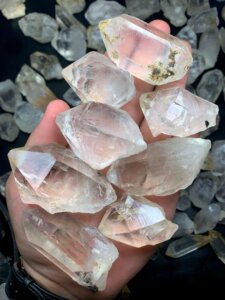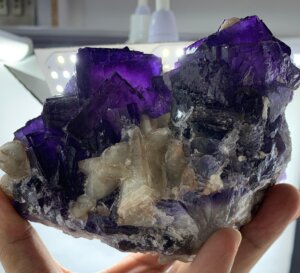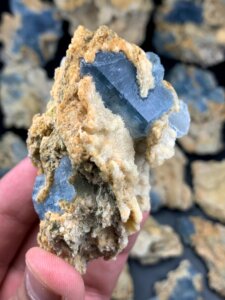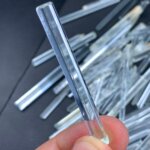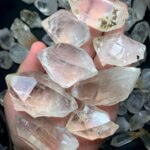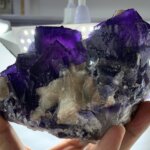Few gemstones capture the calm beauty of the ocean like Aquamarine. Its cool blue hues, crystal clarity, and soothing energy have made it one of the world’s most beloved gemstones — cherished by jewelers, collectors, and metaphysical enthusiasts alike.
But beyond its beauty, the aquamarine mineral specimen has a fascinating geological story, unique crystal formations, and collectible value that make it far more than just a pretty gemstone. In this detailed guide, we’ll explore everything you need to know — from its origins and properties to how to buy and care for genuine aquamarine specimens.
What Is an Aquamarine Mineral Specimen?
An aquamarine mineral specimen is a naturally occurring crystal form of beryl, a mineral family that also includes emerald, morganite, and heliodor. The gemstone’s name comes from the Latin aqua marina, meaning “water of the sea,” reflecting its serene blue-to-greenish-blue tones.
Unlike cut gemstones used in jewelry, mineral specimens are raw, uncut, and often still attached to their host rock (matrix) — making them especially valuable for mineral collectors and museums.
Chemical Composition & Formation
- Chemical Formula: Be₃Al₂Si₆O₁₈
- Crystal System: Hexagonal
- Hardness: 7.5–8 on Mohs scale
- Color Range: Light sky blue to deep sea blue (due to trace amounts of iron)
- Transparency: Transparent to translucent
Aquamarine crystals typically form in pegmatite veins, often alongside minerals like muscovite, feldspar, and tourmaline. The slow crystallization process allows aquamarine to grow into large, well-formed crystals — some of which can weigh several kilograms.
Where Are Aquamarine Mineral Specimens Found?
Aquamarine is found in several regions worldwide, but the quality and color vary depending on the locality. Here are the most famous sources:
- Brazil: Known for some of the largest and most transparent aquamarine crystals ever found, including the legendary Dom Pedro gem.
- Pakistan & Afghanistan: Produce highly prized aquamarines with rich, saturated blue hues from the Skardu and Shigar Valleys in the Himalayas.
- Nigeria & Mozambique: Noted for their vivid color and clean clarity.
- Madagascar: Yields beautiful greenish-blue crystals, often with unique growth patterns.
- United States (Colorado): The Mount Antero area produces collectible aquamarine crystals sought by American mineral enthusiasts.
Each locality adds a distinctive touch — collectors often seek specimens labeled by their origin for authenticity and rarity.
Physical & Optical Properties of Aquamarine
The beauty of an aquamarine specimen lies in its delicate balance between transparency, color, and crystal form.
1. Color and Clarity
The finest aquamarines display a pure, intense blue, while lighter or greenish tones are more common. Unlike emeralds, aquamarine crystals are usually eye-clean with minimal inclusions, giving them a luminous clarity.
2. Crystal Shape
Aquamarine grows in hexagonal prismatic crystals that can reach impressive sizes — sometimes several inches or even feet long. These natural shapes make them visually stunning for display purposes.
3. Pleochroism
Under polarized light, aquamarine can show different shades of blue when viewed from different angles — a property known as pleochroism, adding depth to its color play.
History and Cultural Significance
Aquamarine has enchanted civilizations for centuries.
- Ancient Romans believed it protected sailors and ensured safe voyages across stormy seas.
- Medieval healers used aquamarine for curing eye ailments and calming tempers.
- Modern crystal healers associate it with courage, clarity, and emotional balance.
It is also the birthstone for March, symbolizing youth, hope, and renewal — making it a popular gift gemstone.
Collecting Aquamarine Mineral Specimens
For mineral enthusiasts, an aquamarine specimen is a centerpiece in any collection. Here’s what to consider when building your own:
1. Crystal Quality
- Look for well-terminated crystals (sharp edges and natural points).
- Transparency and rich color significantly increase value.
- Avoid specimens with heavy cracks or cloudiness.
2. Matrix and Associations
Aquamarine often grows with feldspar, muscovite, and quartz. Specimens that include these minerals in balance — or form aesthetic combinations — are especially collectible.
3. Size and Formation
While large crystals are impressive, smaller, perfect formations can be even more desirable to collectors due to their symmetry and clarity.
4. Provenance (Origin)
Always note where your aquamarine was mined. Specimens from famous localities like Pakistan’s Shigar Valley or Brazil’s Minas Gerais fetch premium prices.
Buying Guide: How to Buy an Aquamarine Mineral Specimen Online
When shopping online, especially for high-quality minerals, authenticity and trust are crucial. Here’s how to ensure a safe and smart purchase:
1. Choose Trusted Sellers
Buy only from reputable dealers or online stores specializing in mineral specimens. Look for:
- Detailed product descriptions (locality, size, and clarity)
- High-resolution photos of the actual specimen
- Customer reviews or certifications
2. Check for Natural vs. Treated
Some aquamarine stones undergo heat treatment to enhance their blue color. For collectors, untreated, natural aquamarine specimens are more desirable.
3. Evaluate Lighting
Photographs can make colors appear deeper or lighter. Always check if the image was taken under natural daylight.
4. Price Range
- Small cabinet specimens: $30–$150
- High-quality collector pieces: $300–$1000+
- Museum-grade clusters: Can exceed several thousand dollars
5. Documentation
Request a certificate of authenticity or seller’s note with mine locality — this adds long-term value to your collection.
Caring for Your Aquamarine Mineral Specimen
To maintain its natural luster and clarity, follow these easy care tips:
- Avoid harsh sunlight: Prolonged UV exposure can fade its color.
- Clean gently: Use lukewarm water and a soft cloth; avoid ultrasonic cleaners.
- Handle with care: Though durable, aquamarine can still chip if dropped.
- Display safely: Store in a glass case or shelf away from other hard minerals to prevent scratches.
Metaphysical and Healing Properties
Many collectors also appreciate aquamarine for its energetic qualities:
- Promotes calmness, clarity, and communication
- Encourages courage and confidence
- Balances throat chakra, helping express emotions honestly
While these properties are spiritual in nature, they add an emotional and symbolic layer to aquamarine’s appeal.
Famous Aquamarine Specimens and Gemstones
A few noteworthy examples that highlight aquamarine’s splendor:
- Dom Pedro Aquamarine (Brazil): A 10,363-carat gemstone, the largest cut aquamarine in the world, now displayed at the Smithsonian Institution.
- Shigar Valley Crystals (Pakistan): Exceptional clarity and vibrant blue tones — a favorite among high-end collectors.
- Mount Antero Aquamarine (Colorado): Prized by American collectors for its alpine origin and natural aesthetic.
These legendary finds inspire gem enthusiasts worldwide to explore and collect their own pieces of nature’s artistry.
FAQs About Aquamarine Mineral Specimens
1. How can I tell if an aquamarine specimen is genuine?
Genuine aquamarine will feel cool to the touch, have natural inclusions or zoning, and maintain consistent color throughout. Synthetic versions often look overly flawless.
2. Are aquamarine specimens expensive?
Prices vary depending on color, clarity, and size — small crystals are affordable, but premium, well-formed blue crystals can be quite valuable.
3. What is the best color for aquamarine?
Collectors prefer a deep ocean-blue tone without greenish hues. However, some light-blue specimens are equally beautiful and more budget-friendly.
4. Can aquamarine lose color over time?
Yes, if exposed to strong sunlight for extended periods, the color may fade slightly. Store it in a shaded area when not on display.
5. Is aquamarine the same as blue topaz?
No. While both are blue, aquamarine is natural beryl, whereas blue topaz is usually colorless topaz treated with irradiation to achieve its blue tone.
Conclusion: Discover the Beauty of Aquamarine
An aquamarine mineral specimen is more than just a gemstone — it’s a piece of Earth’s artistic legacy. From its tranquil hues to its fascinating crystal geometry, aquamarine embodies serenity, purity, and timeless elegance.
Whether you’re a gem collector, jewelry designer, or a lover of natural beauty, investing in a high-quality aquamarine specimen connects you with one of nature’s most enchanting creations.
👉 Explore premium aquamarine mineral specimens from trusted sources and add a touch of oceanic elegance to your collection today!

